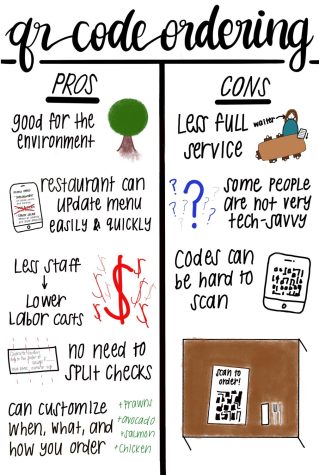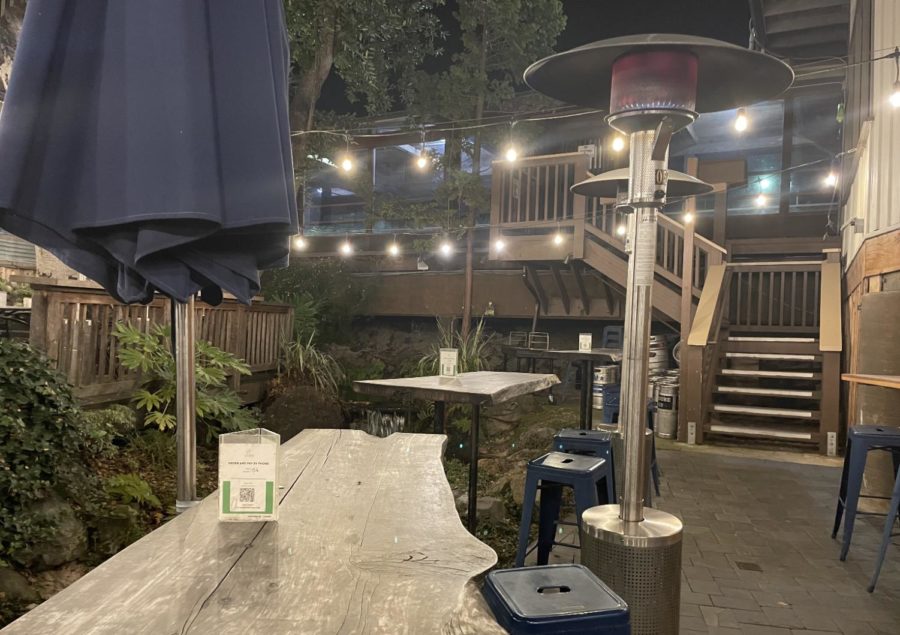The onset of the pandemic has caused an increasing number of restaurants to begin replacing their regular menus with quick response (QR) codes.
Although QR codes were first invented in Japan in 1994, in the last few years, many establishments throughout the world have begun utilizing them. QR codes eliminate the need for paper items, such as menus and pamphlets. Many restaurants have QR codes on every table, and customers scan the black and white square image, which leads them to an online menu where they can order.
QR code ordering existed before the pandemic, but it has seen an explosion in use since the pandemic began. According to QSR Magazine, “Bitly, a link management service, has seen a 750% increase in QR code downloads during the pandemic.”
One local restaurant’s use of QR codes resulted in several benefits.
“Towards the start of COVID-19, the whole idea of people being able to order [themselves] and limiting the interaction with staff was very appealing, especially from a safety perspective,” said Toby McMillen, the owner of Waterdog Tavern in Carlmont Shopping Center.
Additionally, QR codes enable customers to tailor their food orders.
“QR codes allow people to be very much in control of what they order, when they order, and how they order it. A lot of times people aren’t aware of all the different options that are available,” McMillen said. “For example, with a salad, you can add salmon, chicken, prawns, or avocado, and on the app, that’s all clearly listed so people are much more aware of their options.”
QR codes allow people to be very much in control of what they order, when they order, and how they order it.
— Toby McMillen
With ongoing supply chain issues, QR codes allow restaurants to quickly change and remove menu items without reprinting paper menus, which is not only convenient but also good for the environment.
QR code ordering also eliminates the hassle of having to split up checks.
“Let’s say the first-graders moms’ from Central [Elementary School] are having a meetup, with the QR code, they can all order on their own and they love it,” McMillen said. “They don’t have to get a server to separate their check. It’s easier for everybody involved.”
Sophomore Mina Nazari has first-hand experience with this.
“QR code ordering makes things much easier when going out to eat with friends because we can all run our own tabs and don’t have to worry about splitting up a check,” Nazari said.
McMillen plans to continue using the QR code ordering for the outdoor patio area of his restaurant as it works especially well there.

“Outside people used to have to stand in line to order at the counter, but now they can order whatever they want, whenever they want. If they want another beer, another appetizer, or another entree, they just order it. They don’t have to wait for somebody to come to their table. They don’t have to go up and get in line again. So it’s just a lot more convenient. We will always do QR code ordering outside.”
Other people prefer not to interact with a server for social reasons.
“I prefer QR code ordering over having a server come talk to me because I have social anxiety,” said Riley Fish, a junior. “I feel more comfortable because I don’t feel rushed.”
There are also plenty of notable downsides. The most significant one is that many people go to restaurants for the full service that they provide and manually ordering your own meal can take away from that.
“The negative of it is that people don’t get the same level of personal service that they would if they had servers coming to them and taking their order,” McMillen said. “A lot of people really like that interaction with [servers] and they go out because they want to be waited on, they really don’t want to do anything themselves.”
For people unfamiliar with using their phones to access QR codes, the change can be an unwelcome task.
“Another negative is that some people, despite their best efforts, just aren’t the most tech-savvy,” McMillen said. “And others get intimidated by the QR code and aren’t willing to try. Fortunately, I have found that when people actually give it a shot, they usually are able to do it just fine.”
McMillen acknowledges that some of his customers won’t return if it means navigating QR codes.
“I know for a fact that there’s a certain group of people who aren’t going to come in here as long as we keep doing the QR code thing.”
He would like to resume the more traditional server experience inside but faces a significant obstacle.
“I’ll go back to full service as soon as I’m able to hire enough people,” McMillen said. “They’re just not available.”
This story was originally published on Scot Scoop News on January 24, 2022.



























![IN THE SPOTLIGHT: Junior Zalie Mann performs “I Love to Cry at Weddings,” an ensemble piece from the fall musical Sweet Charity, to prospective students during the Fine Arts Showcase on Wednesday, Nov. 8. The showcase is a compilation of performances and demonstrations from each fine arts strand offered at McCallum. This show is put on so that prospective students can see if they are interested in joining an academy or major.
Sweet Charity originally ran the weekends of Sept. 28 and Oct. 8, but made a comeback for the Fine Arts Showcase.
“[Being at the front in the spotlight] is my favorite part of the whole dance, so I was super happy to be on stage performing and smiling at the audience,” Mann said.
Mann performed in both the musical theatre performance and dance excerpt “Ethereal,” a contemporary piece choreographed by the new dance director Terrance Carson, in the showcase. With also being a dance ambassador, Mann got to talk about what MAC dance is, her experience and answer any questions the aspiring arts majors and their parents may have.
Caption by Maya Tackett.](https://bestofsno.com/wp-content/uploads/2024/02/53321803427_47cd17fe70_o-1-1200x800.jpg)
![SPREADING THE JOY: Sophomore Chim Becker poses with sophomores Cozbi Sims and Lou Davidson while manning a table at the Hispanic Heritage treat day during lunch of Sept 28. Becker is a part of the students of color alliance, who put together the activity to raise money for their club.
“It [the stand] was really fun because McCallum has a lot of latino kids,” Becker said. “And I think it was nice that I could share the stuff that I usually just have at home with people who have never tried it before.”
Becker recognizes the importance of celebrating Hispanic heritage at Mac.
“I think its important to celebrate,” Becker said. “Because our culture is awesome and super cool, and everybody should be able to learn about other cultures of the world.”
Caption by JoJo Barnard.](https://bestofsno.com/wp-content/uploads/2024/01/53221601352_4127a81c41_o-1200x675.jpg)






